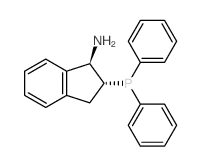1091606-70-0
| Name | (1R,2R)-2-diphenylphosphanyl-2,3-dihydro-1H-inden-1-amine |
|---|---|
| Synonyms |
(1R,2R)-2-(Diphenylphosphino)-2,3-dihydro-1H-inden-1-amine
(1R,2R)-2-(DIPHENYLPHOSPHINO)INDAN-1-AMINE (1R,2R)-1-AMINO-2-(DIPHENYLPHOSPHINO)INDANE (1S,2S)-2-(diphenylphosphino)-2,3-dihydro-1H-inden-1-amine |
| Molecular Formula | C21H20NP |
|---|---|
| Molecular Weight | 317.36400 |
| Exact Mass | 317.13300 |
| PSA | 39.61000 |
| LogP | 4.44430 |
|
Section 1: Product Identification Chemical Name:(1R,2R)-2-(Diphenylphosphino)-2,3-dihydro-1H-inden-1-amine, min. 97% (10wt% in THF) CAS Registry Number:1091606-70-0 Formula:C21H20NP EINECS Number:none Chemical Family:aminophosphine ligand Synonym:(1R,2R)-2-(Diphenylphosphano)-2,3-dihydro-1H-inden-1-amine
Section 2: Composition and Information on Ingredients IngredientCAS NumberPercentACGIH (TWA)OSHA (PEL) Title compound1091606-70-010%no datano data THF109-99-990%50ppm590mg/m3 Section 3: Hazards Identification Harmful if swallowed. Inhalation may cause dizziness, headache and shortness of breath. Irritating to skin, Emergency Overview: eyes and respiratory tract. Possible risk of harm to the unborn child. Primary Routes of Exposure:Inhalation, skin, eyes Eye Contact:Causes moderate irritation to the eyes. Skin Contact:Causes moderate to severe irritation of the skin. Harmful by inhalation. May cause coughing, headache and drowsiness. Irritating to the nose, mucous Inhalation: membranes and respiratory tract. Ingestion:Harmful if swallowed. THF can cause liver damage. Inhalation of vapors causes drowsiness. May cause chest pains, coughing, dizziness, headache and Acute Health Affects: unsciousness. Possible risk of harm to the unborn child. Irritating to skin and eyes. Tetrahydrofuran is an eye and mucous membrane irritant and can cause liver and kidney damage. Possible Chronic Health Affects: risk of irreversible effects. NTP:No IARC:No OSHA:No SECTION 4: First Aid Measures Immediately flush the eyes with copious amounts of water for at least 10-15 minutes. A victim may need Eye Exposure: assistance in keeping their eye lids open. Get immediate medical attention. Wash the affected area with water. Remove contaminated clothes if necessary. Seek medical assistance if Skin Exposure: irritation persists. Remove the victim to fresh air. Closely monitor the victim for signs of respiratory problems, such as difficulty Inhalation: in breathing, coughing, wheezing, or pain. In such cases seek immediate medical assistance. Seek medical attention immediately. Keep the victim calm. Give the victim water (only if conscious). Induce Ingestion: vomiting only if directed by medical personnel. SECTION 5: Fire Fighting Measures Flash Point:1F (THF) Autoignition Temperature:610F (THF) Explosion Limits:1.8% (LEL) 11.8% (UEL) Extinguishing Medium:carbon dioxide, dry powder or foam If this product is involved in a fire, fire fighters should be equipped with a NIOSH approved positive pressure Special Fire Fighting Procedures: self-contained breathing apparatus and full protective clothing. Hazardous Combustion andIf involved in a fire this material may emit irritating fumes. Decomposion Products: Unusual Fire or Explosion Hazards: Highly flammable material. Vapors can form explosive mixtures with air. SECTION 6: Accidental Release Measures Eliminate all potential spark sources. Small spills can be absorbed into vermiculite or other chemical adsorbent Spill and Leak Procedures: suitable for flammable materials. Sweep up the mixture and dispose of properly. SECTION 7: Handling and Storage Store in a tightly sealed container under an inert atmosphere of nitrogen or argon. Keep in a cool, dry, well Handling and Storage: ventilated place. SECTION 8: Exposure Controls and Personal Protection Eye Protection:Always wear approved safety glasses when handling a chemical substance in the laboratory. Skin Protection:Wear protective clothing and gloves. Ventilation:Handle the material in an efficient fume hood. If ventilation is not available a respirator should be worn. The use of respirators requires a Respirator Respirator: Protection Program to be in compliance with 29 CFR 1910.134. Ventilation:Handle the material in an efficient fume hood. Additional Protection:No additional protection required. SECTION 9: Physical and Chemical Properties Color and Form:colorless to pale yellow liq. Molecular Weight:317.36 Melting Point:no data Boiling Point:no data Vapor Pressure:160mm/Hg@25C(THF) Specific Gravity:0.89g/cm2 (THF) Odor:ethereal Solubility in Water:reacts with water SECTION 10: Stability and Reactivity Stability:air sensitive Hazardous Polymerization:no hazardous polymerization Conditions to Avoid:heat, ignition sources, contact with moisture Incompatibility:water, oxidizing agents, halogens, air and mineral acids Decomposition Products:carbon monoxide, carbon dioxide, nitrogen oxides, phosphorous oxides and organic fumes SECTION 11: Toxicological Information Title compound: No information available in the RTECS files. THF: Inhalation(human); TCLo: 25000ppm. Oral(rat); LD50: 1650mg/kg. Inhalation(rat); LC50: 21000ppm/3H. Intraperitoneal(rat); LD50: 2900mg/kg. RTECS Data: Inhalation(mouse); LCLo: 24000mg/m3/2H. Inhalation(rabbit); LC: >1200ppm/4H. Oral(guinea pig); LDLo: 500mg/kg. Inhalation(rat); TCLo: 1800ppm/6H/2Y-1. Carcinogenic Effects:THF: Data available Mutagenic Effects:THF: Possible mutagen Tetratogenic Effects:THF: Possible reproductive effector SECTION 12: Ecological Information Ecological Information:No information available SECTION 13: Disposal Considerations Disposal:Dispose of according to local, state and federal regulations. SECTION 14: Transportation Shipping Name (CFR):Flammable liquids, N.O.S. Hazard Class (CFR):3 Additional Hazard Class (CFR):NA Packaging Group (CFR):I UN ID Number (CFR):UN# 1993 Shipping Name (IATA):Flammable liquid, N.O.S. Hazard Class (IATA):3 Additional Hazard Class (IATA):NA Packaging Group (IATA):I UN ID Number (IATA):UN# 1993 SECTION 15: Regulatory Information TSCA:Not listed in the TSCA inventory SARA (Title 313):Not reportable under SARA 313. Second Ingredient:Listed in the TSCA inventory. Not regulated under SARA SECTION 16 - ADDITIONAL INFORMATION N/A |
